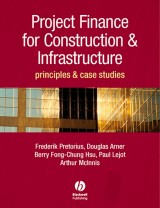Details

Project Finance for Construction and Infrastructure
Principles and Case Studies1. Aufl.
|
115,99 € |
|
| Verlag: | Wiley-Blackwell |
| Format: | |
| Veröffentl.: | 30.04.2008 |
| ISBN/EAN: | 9780470697931 |
| Sprache: | englisch |
| Anzahl Seiten: | 370 |
DRM-geschütztes eBook, Sie benötigen z.B. Adobe Digital Editions und eine Adobe ID zum Lesen.
Beschreibungen
This is a self-contained text on the logic and institutions of project finance, supplemented by a series of project finance case studies illustrating applications in different economic environments, across different jurisdictions and at different stages of development. <br /> <p>It will introduce an analytical framework drawing on applied institutional economics that includes and concentrates primarily on an analysis of the institutional logic behind generic project finance arrangements.<br /> </p> <p> The application of the institutional framework will be demonstrated with project cases from Hong Kong, Thailand, India, Europe and Azerbaijan – each at different stages of development. While each project case will have a general theme and will highlight aspects of interest to built environment professionals, it will primarily be used to illustrate one or more specific PF/PFI principle.</p>
<i>Preface</i> . <p><i>Acknowledgments</i> .</p> <p><i>About the authors</i>.</p> <p><b>1 The Nature of Project Finance</b> .</p> <p>1.1 The world of projects today.</p> <p>1.2 Corporations, finance and projects; important concepts.</p> <p>1.3 The project company business model.</p> <p>1.4 The project cycle.</p> <p>1.5 System concepts and the project company.</p> <p>1.6 Plan of the book.</p> <p>Key Concepts.</p> <p><b>2 Complex Transactions</b> .</p> <p>2.1 Transactions, the cost of transaction, transaction cost economics, and projects.</p> <p>2.2 A more formal approach to disaggregation of transactions.</p> <p>2.3 The influence of agency on transaction costs – agency costs.</p> <p>2.4 Corporate finance context.</p> <p>2.5 Incentive conflicts in corporate finance.</p> <p>2.6 Transaction costs and agency – theoretic logic of the project finance model.</p> <p>Key concepts.</p> <p>Appendix 2.1 Comparison of long-term debt instruments.</p> <p>A2.1.1 Syndicated loans.</p> <p>A2.1.2 International bonds.</p> <p><b>3 Financial Evaluation</b> .</p> <p>3.1 Valuation and the project company.</p> <p>3.2 Valuation and the project company as a single-asset business.</p> <p>3.3 Capital budgeting decisions.</p> <p>Key concepts.</p> <p><b>4 Managing Risk in Project Finance Transactions</b> .</p> <p>4.1 The project cycle revisited.</p> <p>4.2 Risk management approaches.</p> <p>4.3 The project company and risk identification.</p> <p>4.4 Risks in the construction phase.</p> <p>4.5 The institutional environment and risk.</p> <p>4.6 Risk management and project lenders.</p> <p>Key concepts.</p> <p><b>5 Continuing Evolution: from PF to PFI, PPP and beyond</b> .</p> <p>5.1 Introduction.</p> <p>5.2 PFI origins.</p> <p>5.3 Types of PFI.</p> <p>5.4 PFI features.</p> <p>5.5 Procurement process principles.</p> <p>5.6 Contract and control structure.</p> <p>5.7 The special purpose or project vehicle and financing.</p> <p>5.8 PFI/PPP and rational privatisation.</p> <p>5.9 Risk management.</p> <p>5.10 Financial risk in PFI and PPPs.</p> <p>5.11 Challenges for PFI and PP and the responses.</p> <p>5.12 The lessons.</p> <p>Key concepts.</p> <p><b>6 The Relevance of Sound Demand in Infrastructure Project Finance –</b>.</p> <p><b>The Sydney Cross-City Tunnel</b> .</p> <p>6.1 Infrastructure finance: the Sydney cross-city tunnel.</p> <p>6.2 History of the CCT project.</p> <p>6.3 Cheung Kong Infrastructure Holdings Limited.</p> <p>6.4 The bidding process.</p> <p>6.5 Valuing the project.</p> <p>6.6 Assessing project risks.</p> <p>6.7 Capital structure.</p> <p>6.8 Completion of the deal.</p> <p>6.9 Project outcomes.</p> <p><b>7 Financial Structure and Infrastructure Project Finance – The Hong Kong Western Harbour Crossing</b> .</p> <p>7.1 Refinancing the western harbour crossing, Hong Kong.</p> <p>7.2 History of the western harbour crossing.</p> <p>7.3 Valuation of the project.</p> <p><b>8 Institutional Risks and Infrastructure Project Finance – The Dabhol Power Project</b> .</p> <p>8.1 Dabhol power project.</p> <p>8.2 Development of the Dabhol power project.</p> <p>8.3 Power purchase agreement.</p> <p>8.4 Epilogue.</p> <p>8.5 Analysis.</p> <p><b>9 Extreme Complexity in Transacting – Public Private Partnerships at Work in the London Underground</b> .</p> <p>9.1 Public private partnerships: London Underground.</p> <p>9.2 Two countries two systems.</p> <p>9.3 Public private partnership.</p> <p><i>References</i> .</p> <p><i>Index</i></p>
"An interesting publication with many key aims, it looks to supply the concepts of project finance to academics and students by the utilisation of real projects."<br /> <i>Building Engineer<!--end--></i>
Frederik Pretorius & Berry Hsu, Department of Real Estate and Construction, University of Hong Kong;<br /> <p>Paul Lejot & Douglas Arner, Faculty of Law, University of Hong Kong;<br /> </p> <p>Arthur McInnis, Faculty of Law, City University of Hong Kong.</p>
This is a self-contained text on the logic and institutions of project finance, supplemented by a series of project finance case studies illustrating applications in different economic environments, across different jurisdictions and at different stages of development. <br /> <p>It will introduce an analytical framework drawing on applied institutional economics that includes and concentrates primarily on an analysis of the institutional logic behind generic project finance arrangements.<br /> </p> <p> The application of the institutional framework will be demonstrated with project cases from Hong Kong, Thailand, India, Europe and Azerbaijan – each at different stages of development. While each project case will have a general theme and will highlight aspects of interest to built environment professionals, it will primarily be used to illustrate one or more specific PF/PFI principle.</p>
"An interesting publication with many key aims, it looks to supply the concepts of project finance to academics and students by the utilisation of real projects."<br /> <i>Building Engineer<!--end--></i>

















